克隆~英语
- 格式:ppt
- 大小:108.50 KB
- 文档页数:15
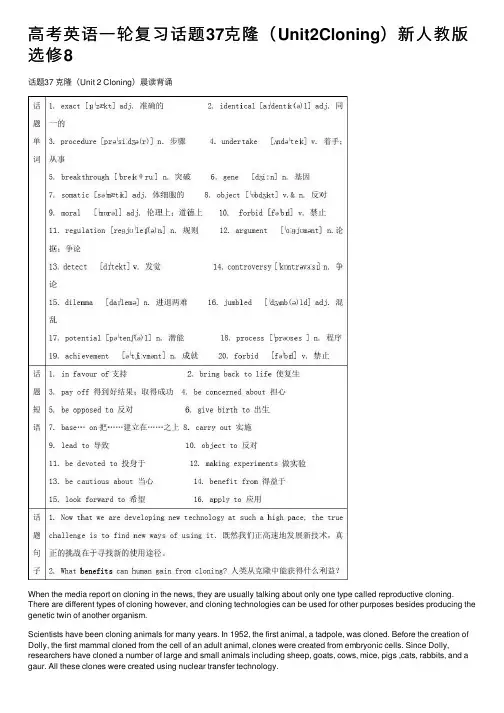
⾼考英语⼀轮复习话题37克隆(Unit2Cloning)新⼈教版选修8话题37 克隆(Unit 2 Cloning)晨读背诵When the media report on cloning in the news, they are usually talking about only one type called reproductive cloning. There are different types of cloning however, and cloning technologies can be used for other purposes besides producing the genetic twin of another organism.Scientists have been cloning animals for many years. In 1952, the first animal, a tadpole, was cloned. Before the creation of Dolly, the first mammal cloned from the cell of an adult animal, clones were created from embryonic cells. Since Dolly, researchers have cloned a number of large and small animals including sheep, goats, cows, mice, pigs ,cats, rabbits, and a gaur. All these clones were created using nuclear transfer technology.汉语⼤意:当媒体报道的克隆的消息,他们通常所说的只有⼀种称为⽣殖性克隆的类型。
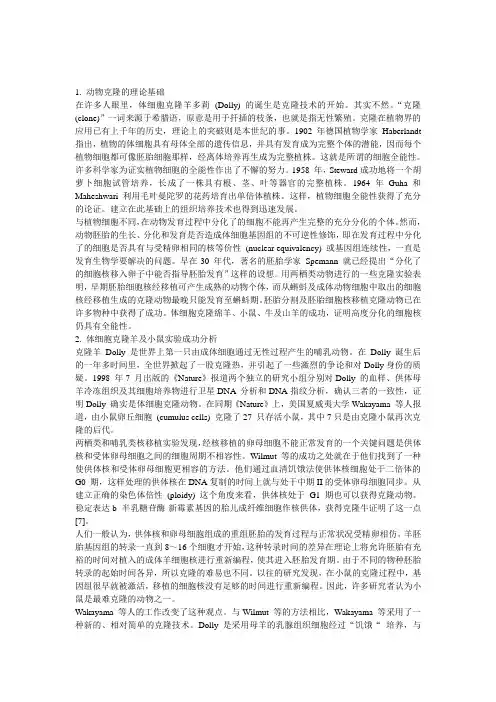
1. 动物克隆的理论基础在许多人眼里,体细胞克隆羊多莉(Dolly) 的诞生是克隆技术的开始。
其实不然。
“克隆(clone)”一词来源于希腊语,原意是用于扦插的枝条,也就是指无性繁殖。
克隆在植物界的应用已有上千年的历史,理论上的突破则是本世纪的事。
1902 年德国植物学家Haberlandt 指出,植物的体细胞具有母体全部的遗传信息,并具有发育成为完整个体的潜能,因而每个植物细胞都可像胚胎细胞那样,经离体培养再生成为完整植株。
这就是所谓的细胞全能性。
许多科学家为证实植物细胞的全能性作出了不懈的努力。
1958 年,Steward成功地将一个胡萝卜细胞试管培养,长成了一株具有根、茎、叶等器官的完整植株。
1964年Guha 和Maheshwari利用毛叶曼陀罗的花药培育出单倍体植株。
这样,植物细胞全能性获得了充分的论证。
建立在此基础上的组织培养技术也得到迅速发展。
与植物细胞不同,在动物发育过程中分化了的细胞不能再产生完整的充分分化的个体。
然而,动物胚胎的生长、分化和发育是否造成体细胞基因组的不可逆性修饰,即在发育过程中分化了的细胞是否具有与受精卵相同的核等价性(nuclear equivalency) 或基因组连续性,一直是发育生物学要解决的问题。
早在30 年代,著名的胚胎学家Spemann 就已经提出“分化了的细胞核移入卵子中能否指导胚胎发育”这样的设想。
用两栖类动物进行的一些克隆实验表明,早期胚胎细胞核经移植可产生成熟的动物个体,而从蝌蚪及成体动物细胞中取出的细胞核经移植生成的克隆动物最晚只能发育至蝌蚪期。
胚胎分割及胚胎细胞核移植克隆动物已在许多物种中获得了成功。
体细胞克隆绵羊、小鼠、牛及山羊的成功,证明高度分化的细胞核仍具有全能性。
2. 体细胞克隆羊及小鼠实验成功分析克隆羊Dolly 是世界上第一只由成体细胞通过无性过程产生的哺乳动物。
在Dolly 诞生后的一年多时间里,全世界掀起了一股克隆热,并引起了一些激烈的争论和对Dolly身份的质疑。
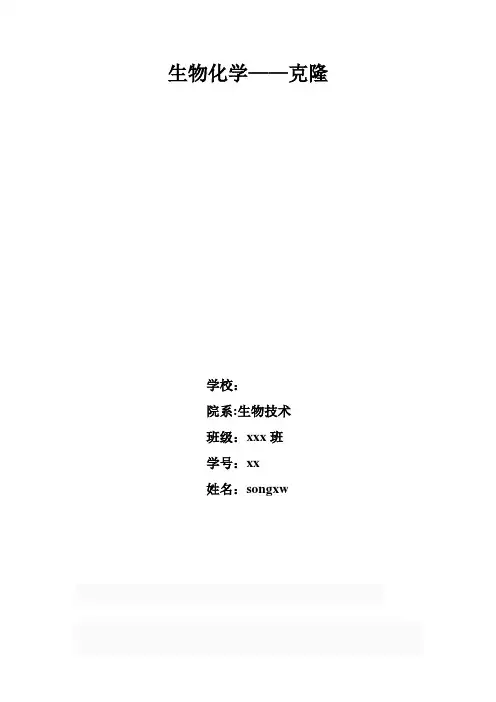
生物化学——克隆学校:院系:生物技术班级:xxx班学号:xx姓名:songxw克隆克隆是英文"clone"或"cloning"的音译,而英文"clone"则起源于希腊文"Klone",原意是指以幼苗或嫩枝插条,以无性繁殖或营养繁殖的方式培育植物,如扦插和嫁接。
在大陆译为“无性繁殖”在台湾与港澳一般意译为复制或转殖或群殖。
中文也有更加确切的词表达克隆,“无性繁殖”、“无性系化”以及“纯系化”。
克隆是指生物体通过体细胞进行的无性繁殖,以及由无性繁殖形成的基因型完全相同的后代个体组成的种群。
通常是利用生物技术由无性生殖产生与原个体有完全相同基因组织后代的过程。
另有相关书籍和影视作品以此为题。
克隆的历史:鲤鱼:1963年,中国科学家童第周早在1963年就通过将一只雄性鲤鱼的遗传物质注入雌性鲤鱼的卵中从而成功克隆了一只雌性鲤鱼,比多利羊的克隆早了33年。
绵羊:1996年,多利(Dolly)猕猴:2000年1月,Tetra,雌性猪:2000年3月,5只苏格兰PPL小猪;8月,Xena,雌性牛:2001年,Alpha和Beta,雄性猫:2001年底,CopyCat(CC),雌性鼠:2002年兔:2003年3-4月分别在法国和朝鲜独立地实现;骡:2003年5月,爱达荷Gem,雄性;6月,犹他先锋,雄性鹿:2003年,Dewey马:2003年,Prometea,(普罗米修斯)雌性狗:2005年,韩国首尔大学实验队,史纳比猪:2005年8月8日,中国第一头供体细胞克隆。
克隆的定义:1963 年J.B.S.Haldane在题为“人类种族在未来二万年的生物可能性”的演讲上采用“克隆(Clone)”的术语。
科学家把人工遗传操作动物繁殖的过程叫“克隆”,这门生物技术叫“克隆技术”,其本身的含义是无性繁殖(中国大陆的翻译),即由同一个祖先细胞分裂繁殖而形成的纯细胞系,该细胞系中每个细胞的基因彼此相同。
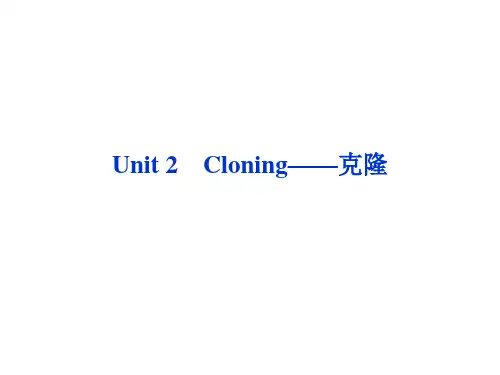
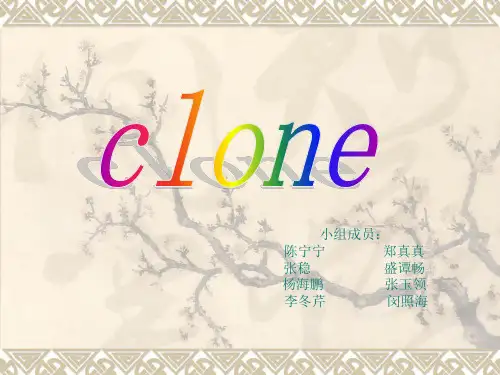
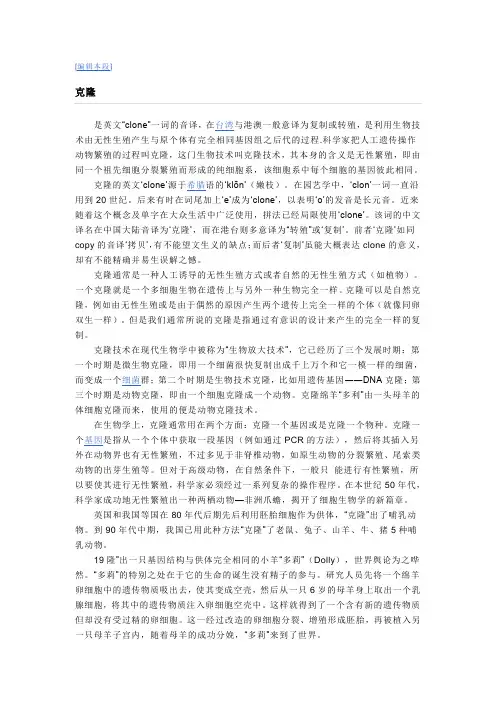
[编辑本段]克隆是英文“clone”一词的音译,在台湾与港澳一般意译为复制或转殖,是利用生物技术由无性生殖产生与原个体有完全相同基因组之后代的过程.科学家把人工遗传操作动物繁殖的过程叫克隆,这门生物技术叫克隆技术,其本身的含义是无性繁殖,即由同一个祖先细胞分裂繁殖而形成的纯细胞系,该细胞系中每个细胞的基因彼此相同。
克隆的英文…clone‟源于希腊语的…klōn‟(嫩枝)。
在园艺学中,…clon‟一词一直沿用到20世纪。
后来有时在词尾加上…e‟成为…clone‟,以表明…o‟的发音是长元音。
近来随着这个概念及单字在大众生活中广泛使用,拼法已经局限使用…clone‟。
该词的中文译名在中国大陆音译为…克隆‟,而在港台则多意译为“转殖”或…复制‟。
前者…克隆‟如同copy的音译…拷贝‟,有不能望文生义的缺点;而后者…复制‟虽能大概表达clone的意义,却有不能精确并易生误解之憾。
克隆通常是一种人工诱导的无性生殖方式或者自然的无性生殖方式(如植物)。
一个克隆就是一个多细胞生物在遗传上与另外一种生物完全一样。
克隆可以是自然克隆,例如由无性生殖或是由于偶然的原因产生两个遗传上完全一样的个体(就像同卵双生一样)。
但是我们通常所说的克隆是指通过有意识的设计来产生的完全一样的复制。
克隆技术在现代生物学中被称为“生物放大技术”,它已经历了三个发展时期:第一个时期是微生物克隆,即用一个细菌很快复制出成千上万个和它一模一样的细菌,而变成一个细菌群;第二个时期是生物技术克隆,比如用遗传基因――DNA克隆;第三个时期是动物克隆,即由一个细胞克隆成一个动物。
克隆绵羊“多利”由一头母羊的体细胞克隆而来,使用的便是动物克隆技术。
在生物学上,克隆通常用在两个方面:克隆一个基因或是克隆一个物种。
克隆一个基因是指从一个个体中获取一段基因(例如通过PCR的方法),然后将其插入另外在动物界也有无性繁殖,不过多见于非脊椎动物,如原生动物的分裂繁殖、尾索类动物的出芽生殖等。
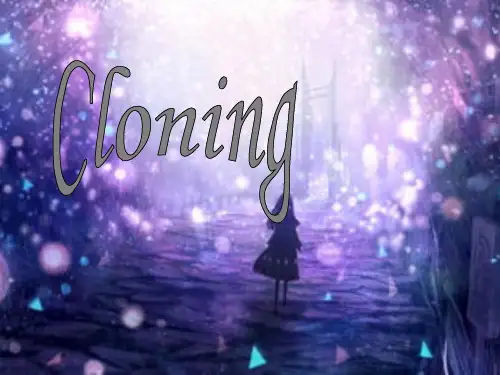
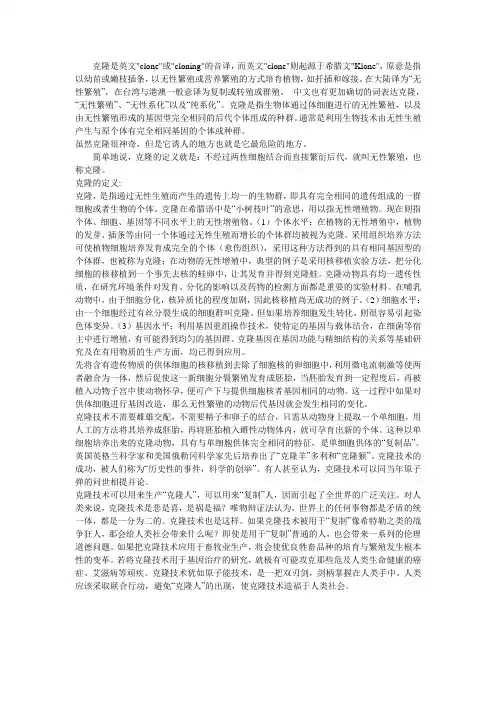
克隆是英文"clone"或"cloning"的音译,而英文"clone"则起源于希腊文"Klone",原意是指以幼苗或嫩枝插条,以无性繁殖或营养繁殖的方式培育植物,如扦插和嫁接。
在大陆译为“无性繁殖”,在台湾与港澳一般意译为复制或转殖或群殖。
中文也有更加确切的词表达克隆,“无性繁殖”、“无性系化”以及“纯系化”。
克隆是指生物体通过体细胞进行的无性繁殖,以及由无性繁殖形成的基因型完全相同的后代个体组成的种群。
通常是利用生物技术由无性生殖产生与原个体有完全相同基因的个体或种群。
虽然克隆很神奇,但是它诱人的地方也就是它最危险的地方。
简单地说,克隆的定义就是:不经过两性细胞结合而直接繁衍后代,就叫无性繁殖,也称克隆。
克隆的定义:克隆,是指通过无性生殖而产生的遗传上均一的生物群,即具有完全相同的遗传组成的一群细胞或者生物的个体。
克隆在希腊语中是“小树枝叶”的意思,用以指无性增殖物。
现在则指个体、细胞、基因等不同水平上的无性增殖物。
(1)个体水平:在植物的无性增殖中,植物的发芽、插条等由同一个体通过无性生殖而增长的个体群均被视为克隆。
采用组织培养方法可使植物细胞培养发育成完全的个体(愈伤组织),采用这种方法得到的具有相同基因型的个体群,也被称为克隆;在动物的无性增殖中,典型的例子是采用核移植实验方法,把分化细胞的核移植到一个事先去核的蛙卵中,让其发育并得到克隆蛙。
克隆动物具有均一遗传性质,在研究环境条件对发育、分化的影响以及药物的检测方面都是重要的实验材料。
在哺乳动物中,由于细胞分化,核异质化的程度加剧,因此核移植尚无成功的例子。
(2)细胞水平:由一个细胞经过有丝分裂生成的细胞群叫克隆。
但如果培养细胞发生转化,则很容易引起染色体变异。
(3)基因水平:利用基因重组操作技术,使特定的基因与载体结合,在细菌等宿主中进行增殖,有可能得到均匀的基因群。
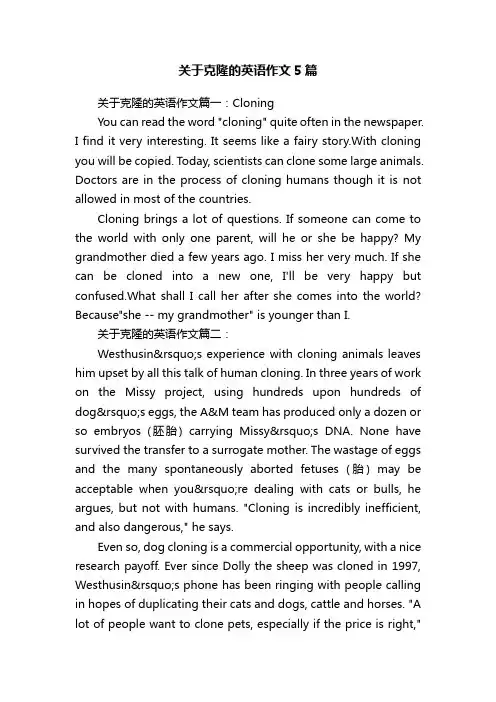
关于克隆的英语作文5篇关于克隆的英语作文篇一:CloningYou can read the word "cloning" quite often in the newspaper.I find it very interesting. It seems like a fairy story.With cloning you will be copied. Today, scientists can clone some large animals. Doctors are in the process of cloning humans though it is not allowed in most of the countries.Cloning brings a lot of questions. If someone can come to the world with only one parent, will he or she be happy? My grandmother died a few years ago. I miss her very much. If she can be cloned into a new one, I'll be very happy but confused.What shall I call her after she comes into the world? Because"she -- my grandmother" is younger than I.关于克隆的英语作文篇二:Westhusin’s experience with cloning animals leaves him upset by all this talk of human cloning. In three years of work on the Missy project, using hundreds upon hundreds of dog’s eggs, the A&M team has produced only a dozen or so embryos (胚胎) carrying Missy’s DNA. None have survived the transfer to a surrogate mother. The wastage of eggs and the many spontaneously aborted fetuses (胎) may be acceptable when you’re dealing with cats or bulls, he argues, but not with humans. "Cloning is incredibly inefficient, and also dangerous," he says.Even so, dog cloning is a commercial opportunity, with a nice research payoff. Ever since Dolly the sheep was cloned in 1997, Westhusin’s phone has been ringing with people calling in hopes of duplicating their cats and dogs, cattle and horses. "A lot of people want to clone pets, especially if the price is right,"says Westhusin. Cost is no obstacle for Missy’s mysterious billionaire owner; he’s put up $3.7 million so far to fund A&M’s research.Contrary to some media reports, Missy is not dead. The owner wants a twin to carry on Missy’s fine qualities after she does die. The prototype is, by all accounts, athletic, good-natured and supersmart. Missy’s master does not expect an exact copy of her. He knows her clone may not have her temperament. In a statement of purpose, Missy’s owner and the A&M team say they are "both looking forward to studying the ways that her clones differ from Missy."Besides cloning a great dog, the project may contribute insight into the old question of nature vs. nurture. It could also lead to the cloning of special rescue dogs and many endangered animals.However, Westhusin is cautious about his work. He knows that even if he gets a dog pregnant, the offspring, should they survive, will face the problems shown at birth by other cloned animals: abnormalities like immature lungs and heart and weight problems~ "Why would you ever want to clone humans," Westhusin asks, "when we’re not even close to getting it worked out in animals yet?关于克隆的英语作文篇三:CloningToday’s technology develops so quickly that many impossible things become true; the cloning technology is the example. What is cloning? Cloning is a process used to create an exact copy of a mammal by using the complete genetic material of a regular body cell. Different from the common propagate, cloning need only one cell and without sex. In 1997, the great news shocked the whole world that the British scientists createda lamp named Dolly from a single cell, miraculously; the cell had been taken from the udder of adult sheep, which show the first cloning experiment was successful.When the cloning technology improves so quickly, many scientists and doctors have different opinions, someone think it is good but someone think it is bad. Cloning can bring many benefits to the human, such as rejuvenation, helpful for Defective genes, Liver failure, Kidney failure and Leukemia. These disease are very different to cure, if we use the cloning technology we can change the Gene’s DNA order, so we can save lots of people. But cloning still has some problems. The scientists found that the cloning animal’s Gene has a little different from the original animal. So the life will shorter than the real life. The fact proved that, the cloning sheep Dolly has died. It only has the half life of the common sheep.In my own opinion I agree to clone the endangered animal and disagree with cloning human. Because I think the cloning technology should be respected. It really can bring us many benefits; further more it can develop the science of human. If clone the human, there will, however, be many problems, the population is the biggest problem. May be some people will use the cloning people to start the war. So I am against cloning human.Also many countries disagree to clone people. The government makes the laws about cloning. There are laws against human cloning in Canada, Denmark, England, Norway, Spain, and the UK. Even in the USA, the government doesn’t allow to clone human. (Because in USA, the human right is higher than everything)In the end, I think cloning is new technology, it should be accepted, how to look upon this technique, first we should knowthe advantages and disadvantages, then we should know the effect of cloning for human and the animal, third we will take the action: To advocate the animal cloning but be against with the human cloning.关于克隆的英语作文篇四:My View on CloneWith the repid development of technology, clone comes to the world. It can duplicate creature, which means it can make contribution to the production. People can pay a little and get a lot in the end. However, it also has disavantages. I think as the development of the high-tech, people can use clone to copy humen beings. It’s so horrible for me to know that there is someone the same with me. But in general, clone has more advantages than disadvantages.随着科技的迅速发展,克隆来到了这个世界。
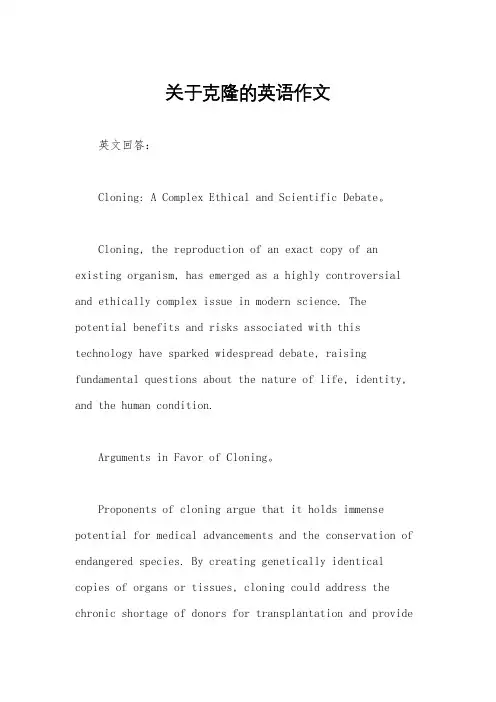
关于克隆的英语作文英文回答:Cloning: A Complex Ethical and Scientific Debate。
Cloning, the reproduction of an exact copy of an existing organism, has emerged as a highly controversial and ethically complex issue in modern science. The potential benefits and risks associated with this technology have sparked widespread debate, raising fundamental questions about the nature of life, identity, and the human condition.Arguments in Favor of Cloning。
Proponents of cloning argue that it holds immense potential for medical advancements and the conservation of endangered species. By creating genetically identical copies of organs or tissues, cloning could address the chronic shortage of donors for transplantation and providelife-saving treatments for various diseases. Additionally, cloning could assist in preserving genetic diversity by reintroducing extinct species or creating genetic backups of critically endangered populations.Arguments Against Cloning。
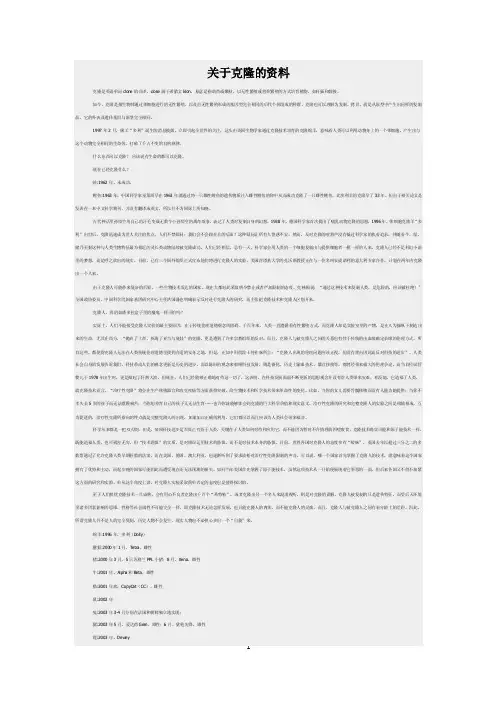
关于克隆的资料克隆是英语单词clon e的音译,clon e源于希腊文klon,原意是指幼苗或嫩枝,以无性繁殖或营养繁殖的方式培育植物,如杆插和嫁接。
如今,克隆是指生物体通过体细胞进行的无性繁殖,以及由无性繁殖形成的基因型完全相同的后代个体组成的种群。
克隆也可以理解为复制、拷贝,就是从原型中产生出同样的复制品,它的外表及遗传基因与原型完全相同。
1997年2月,绵羊“多利”诞生的消息披露,立即引起全世界的关注,这头由英国生物学家通过克隆技术培育的克隆绵羊,意味着人类可以利用动物身上的一个体细胞,产生出与这个动物完全相同的生命体,打破了千古不变的自然规律。
什么东西可以克隆?应该说有生命的都可以克隆。
现在已经克隆什么?蛙:1962年,未成功。
鲤鱼:1963年,中国科学家童第周早在1963年就通过将一只雄性鲤鱼的遗传物质注入雌性鲤鱼的卵中从而成功克隆了一只雌性鲤鱼,比多利羊的克隆早了33年。
但由于相关论文是发表在一本中文科学期刊,并没有翻译成英文,所以并不为国际上所知晓。
古代神话里孙悟空用自己的汗毛变成无数个小孙悟空的离奇故事,表达了人类对复制自身的幻想。
1938 年,德国科学家首次提出了哺乳动物克隆的思想,1996年,体细胞克隆羊“多利”出世后,克隆迅速成为世人关注的焦点,人们不禁疑问:我们会不会跟在羊的后面?这种疑问让所有人惶惑不安。
然而,反对克隆的喧嚣声没有抵过科学家的执着追求,伴随着牛、鼠、猪乃至猴这种与人类生物特征最为相近的灵长类动物陆续被克隆成功,人们已经相信,总有一天,科学家会用人类的一个细胞复制出与提供细胞者一模一样的人来,克隆人已经不是科幻小说里的梦想,而是呼之欲出的现实。
目前,已有三个国外组织正式宣布他们将进行克隆人的实验,美国肯塔基大学的扎沃斯教授正在与一位名叫安提诺利的意大利专家合作,计划在两年内克隆出一个人来。
由于克隆人可能带来复杂的后果,一些生物技术发达的国家,现在大都对此采取明令禁止或者严加限制的态度。
高二年级克隆的英语作文高二年级关于克隆的英语作文(通用15篇)导语:从前,克隆技术是人们一种美好的憧憬;现在,克隆再也不是遐想,克隆羊“多利”的问世已经证明了人类科学技术的腾飞和美好的未来。
下面是小编为大家整理的关于克隆的英语作文,希望对大家有所帮助。
高二年级克隆的英语作文篇1With the repid development of technology, clone comes to the world. It can duplicate creature, which means it can make contribution to the production. People can pay a little and get a lot in the end. However, it also has disavantages. I think as the development of the high-tech, people can use clone to copy humen beings. It’s so horrible for me to know that there is someone the same with me. But in general, clone has more advantages than disadvantages.随着科技的迅速发展,克隆来到了这个世界。
克隆技术可以复制生物,这意味着它可以为生产做贡献。
人们可以付一点,最后得到很多。
但是它也是有缺点的。
我觉得随着高科技的发展,人们可以使用克隆技术来复制人类。
是多么的可怕认识到有一个和自己在一模一样的人。
不过总的来说,克隆的优点多于缺点。
高二年级克隆的英语作文篇2Westhusin’s experience with cloning animals leaves him upset by all this talk of human cloning. In three years of work on the Missy project, using hundreds upon hundreds of dog’s eggs, the A&M team has produced only a dozen or so embryos (胚胎) carrying Missy’s DNA. None have survived the transfer to a surrogate mother. The wastage of eggs and the many spontaneously aborted fetuses (胎) may be acceptable when you’re dealing with cats or bulls, he argue s, but not withhumans. "Cloning is incredibly inefficient, and also dangerous," he says.Even so, dog cloning is a commercial opportunity, with a nice research payoff. Ever since Dolly the sheep was cloned in 1997, Westhusin’s phone has been ringing with people calling in hopes of duplicating their cats and dogs, cattle and horses. "A lot of people want to clone pets, especially if the price is right," says Westhusin. Cost is no obstacle for Missy’s mysterious billionaire owner; he’s put up $3.7 million so far to fund A&M’s research.Contrary to some media reports, Missy is not dead. The owner wants a twin to carry on Missy’s fine qualities after she does die. The prototype is, by all accounts, athletic, good-natured and supersmart. Missy’s master does not expect an exact copy of her. He knows her clone may not have her temperament. In a statement of purpose, Missy’s owner and the A&M team say they are "both looking forward to studying the ways that her clones differ from Missy."Besides cloning a great dog, the project may contribute insight into the old question of nature vs. nurture. It could also lead to the cloning of special rescue dogs and many endangered animals.However, Westhusin is cautious about his work. He knows that even if he gets a dog pregnant, the offspring, should they survive, will face the problems shown at birth by other cloned animals: abnormalities like immature lungs and heart and weight problems~ "Why would you ever want to clone humans," Westhusin asks, "when we’re not even close to getting it worked out in animals yet?高二年级克隆的英语作文篇3You can read the word "cloning" quite often in the newspaper.I find it very interesting. It seems like a fairy story.With cloning you will be copied. Today, scientists can clone some large animals. Doctors are in the process of cloning humans though it is not allowed in most of the countries.Cloning brings a lot of questions. If someone can come to the world with only one parent, will he or she be happy? My grandmother died a few years ago. I miss her very much. If she can be cloned into a new one, I'll be very happy but confused.What shall I call her after she comes into the world? Because"she -- my grandmother" is younger than I.高二年级克隆的英语作文篇4Today’s technology develops so quickly that many impossible things become true; the cloning technology is the example. What is cloning? Cloning is a process used to create an exact copy of a mammal by using the complete genetic material of a regular body cell. Different from the common propagate, cloning need only one cell and without sex. In 1997, the great news shocked the whole world that the British scientists created a lamp named Dolly from a single cell, miraculously; the cell had been taken from the udder of adult sheep, which show the first cloning experiment was successful.When the cloning technology improves so quickly, many scientists and doctors have different opinions, someone think it is good but someone think it is bad. Cloning can bring many benefits to the human, such as rejuvenation, helpful for Defective genes, Liver failure, Kidney failure and Leukemia. These disease are very different to cure, if we use the cloning technology we can change the Gene’s DNA order, so we can save lots of people. But cloning still has some problems. The scientists found that the cloning animal’s Gene has a little different from the originalanimal. So the life will shorter than the real life. The fact proved that, the cloning sheep Dolly has died. It only has the half life of the common sheep.In my own opinion I agree to clone the endangered animal and disagree with cloning human. Because I think the cloning technology should be respected. It really can bring us many benefits; further more it can develop the science of human. If clone the human, there will, however, be many problems, the population is the biggest problem. May be some people will use the cloning people to start the war. So I am against cloning human.Also many countries disagree to clone people. The government makes the laws about cloning. There are laws against human cloning in Canada, Denmark, England, Norway, Spain, and the UK. Even in the USA, the government doesn’t allow to clone human. (Because in USA, the human right is higher than everything)In the end, I think cloning is new technology, it should be accepted, how to look upon this technique, first we should know the advantages and disadvantages, then we should know the effect of cloning for human and the animal, third we will take the action: To advocate the animal cloning but be against with the human cloning.高二年级克隆的英语作文篇5Cloning technology, an asexual reproduction technology, is a great progress and breakthrough of human and technology, on which scientists have achieved remarkable results.However, cloning is a mixed blessing. In a sense, it brings countless benefits to us. Firstly, by virtue of the technology, cloning change the genotype of crops, producing a large of number of disease resistance, inset resistance and other newvarieties, which resulting in improving the production of crops greatly. Secondly, it can cultivate a mass of fine varieties of livestock to bring more income to people, thus improving our living standard.Thirdly, therapeutic cloning provides more living chance to those who suffer serious disease difficult to cure so that their families and their themselves can get rid of the plight. Last but not least, it is conducive to clone the endangered animals and plants and protect the environment and species diversity.There is no doubt that cloning have make great differences to mankind, in essence, it also has cons. On the one hand,from the perspective of social ethics, the reproductive cloning is an intervene to natural development of human being, possibly disobeying the natural law. On the other hand, from the family’s stand point, what change the harmonious relationship among family members is the collapse of the normal human moral order. What ’s more, on the sexual ethics, the cloning will totally change the way of fertility which is based on the affection between each other, in some way causing the lack of love in the world. To be honest, what really get in the way of cloning is that the technology is not so mature by virtue of high stillbirth rates, fetal anomalies, death soon after birth, et cetera.As far as I am concerned, I don not subscribe to cloning, especially reproductive cloning. A good many people attempt to do something against nature via cloning to serve their evil purpose, which will lead to inevitable chaos,threating our peaceful world. What I want to say is t hat”technology is a queer thing; it brings you great gifts with one hand,and it stabs you in the back with the other”.with many problems cloning brings in, I have no reason to send support to it and I will not come to tems with those who back the cloning.高二年级克隆的英语作文篇6With the repid development of technology, clone comes to the world. It can duplicate creature, which means it can make contribution to the production. People can pay a little and get a lot in theend. However, it also has disavantages.I think as the development of the high-tech, people can use clone to copy humen beings. It’s so horrible for me to know that there is someone the same with me. But in general, clone has more advantages than disadvantages.高二年级克隆的.英语作文篇7If I can clone, I want to clone a lot of me who can do all kinds of things.I want to clone a working me, so I will never look at my mother's busy figure and feel sad! I also want to clone a person who can learn. When I am upset that I can't do the difficult Mathematical Olympiad, she will open up the way to solve the problem for me. I want to clone a person who can play. When I am lonely, she can play with me to the fullest. I want to clone a person who can play the piano and Practice for me every day, so that I can read my favorite extracurricular readings beautifully! Of course, I need to clone a poet who can write poems. She can help me write many poems, so I can become a little poet....If I can clone, I must clone many of me. I wish this wish could come true earlier!假如我会克隆,我要克隆好多能干各种事情的我。
Cloning is the replication of an exact genetic copy of an organism by use of a somatic tissue (or cell) from the donor organism. Cloning can be used in humans, human organs, or evenanimals.克隆是利用体细胞组织的一个确切的一个生物体的遗传复制的复制(或细胞)从供体生物。
克隆技术可应用于人类,人类的器官,甚至动物。
A benefit of cloning is cloning human organs or body parts. If a person has a dysfunctional liver or heart then they could get it cloned and get a brand new one. These are some of the benefits of cloning.克隆的一个好处是克隆人体器官或身体部位。
如果一个人有一个不正常的肝脏或心脏就可以得到克隆并获得一个新品牌。
这些都是一些好处的克隆。
Cloning can bring many benefits to the human, such as rejuvenation, helpful for Defective genes, Liver failure, Kidney failure and Leukemia. These disease are very different to cure, if we use the cloning technology we can change the Gene’s DNA order, so we can save lots of people.克隆也会给人类带来很多好处,如振兴,有利于缺陷基因,肝功能衰竭,肾功能衰竭与白血病。
英语作文克隆的利弊Cloning, the process of creating genetically identical copies of organisms, has been a topic of debate for many years. While some argue that cloning can bring benefits such as medical advancements, others believe that it can lead to ethical and moral issues. In this essay, I will discuss the advantages and disadvantages of cloning.On the one hand, cloning can have many benefits. For example, it can be used to create genetically identical animals for medical research, which can help scientists find cures for diseases. Additionally, cloning can also be used to produce better quality crops and livestock, which can lead to increased food production and more efficient farming methods.On the other hand, cloning can also have negative consequences. One major concern is that it can lead to a loss of genetic diversity, which can make organisms more susceptible to disease and environmental changes. Furthermore, cloning can also raise ethical issues, such as the possibility of creating human clones for organ donation or other purposes, which some argue is morally wrong.In conclusion, while cloning has the potential to bring many benefits, it also has its drawbacks. As technology continues to advance, it isimportant that we carefully consider the implications of cloning and weigh the potential risks and benefits before making any decisions.。
英语作文克隆的利弊Cloning, as a scientific concept, presents both advantages and disadvantages that warrant careful consideration. In this essay, we will explore the pros and cons of cloning, particularly focusing on its implications in English.One of the primary benefits of cloning is its potential to advance medical research and treatments. Cloning allows scientists to create genetically identical organisms, which can be instrumental in studying diseases and developing targeted therapies. For instance, in the field of English, cloning can be used to create animal models with specific language-related genetic traits, aiding in the understanding of language acquisition and communication disorders.Furthermore, cloning has the potential to preserve endangered species and biodiversity. By cloning endangered animals, such as certain bird species or marine mammals,scientists can prevent their extinction and restore balance to ecosystems. In the realm of language preservation, cloning could theoretically be applied to preserve endangered languages by creating genetic replicas of native speakers, although this remains a speculative and ethically complex proposition.However, despite these advantages, cloning also raises significant ethical and social concerns. One of the foremost ethical dilemmas is the issue of identity and individuality. Clones, especially human clones, may face challenges in establishing their unique identities and may experience psychological pressure due to societal expectations and comparisons with their genetic donors. In the context of English, cloning individuals for their linguistic abilities could lead to questions ofauthenticity and undermine the diversity of language expression.Moreover, cloning poses risks to genetic diversity. The focus on creating identical organisms can reduce genetic variation, making populations more vulnerable to diseasesand environmental changes. This reduction in diversity is analogous to the potential homogenization of language that could result from cloning individuals with specific linguistic traits, leading to the loss of linguistic diversity and cultural richness.Another concern is the misuse of cloning technology for unethical purposes, such as reproductive cloning or creating clones for organ harvesting. These practices raise serious moral and legal questions and highlight the needfor strict regulations and ethical guidelines in cloning research.In conclusion, cloning presents a complex array of benefits and drawbacks. While it offers potential advancements in medical research, conservation efforts, and possibly language studies, its ethical implications and risks to diversity and individuality cannot be overlooked. As society continues to grapple with the possibilities and limitations of cloning, it is essential to approach this technology with caution, emphasizing responsible research practices and ethical considerations.。
1. Cloning——genetic material——identical copy——living organism.克隆——基材材料——同样的——复制品——有机体、生物体——2. ——come up of——body organs——replica——想出——人体器官——复制品——3. ——beneficial to——kidney——in the long run——a transplant organ.有益的——肾——最后——移植的器官——4. ——expand the scope of——enhance the possibilities of conquering diseases ——the Parkinson’s disease——incurable.扩展——范围——增加战胜疾病的机会——帕金森症——不可治愈的——5. ——endangered species——extinction——maintain natural——a continuous natural life cycle.濒危物种——灭绝——维持自然平衡——延续的自然生物循环——6. ——infertile——characteristics——不育的——特点、特征——7. ——artificial insemination——人工受精——8. In reality——infertile——donated sperm, eggs, or embryos.事实上——不育的——(他人)捐赠的精子、卵子或者胚胎——9. ——livestock——ideal characters——manufacture biological products——as proteins——家禽——完美特点——生产、制造——生产产品——蛋白质——10. Cloning could be used in various ways to benefit the lives of humans.11. ——infertile, genetically at-risk——不育的——有基因缺陷的——12. ——reproduce——homosexual——spin off technologies——reproduction 繁殖、复制——同性恋的——创新科技——繁殖——13. ——unconstitutional——deprive——of——违反宪法的——剥夺——14. ——transplant organs——器官移植——15. ——sperm——精子——16. ——a genetic defect——基因缺陷——17. ——improving the quality of life改善生活质量——18. Cloning could help improve the life of future generations.19. Genetic engineering——yield unprecedented——usher in——gene defects, bacterial disease——aging——a thing of the past基因工程——产生——空前的——引领——基因缺陷——细菌疾病——老化——明日黄花——20. ——adopt——biologically unrelated收养——无血缘关系的——21. ——cure genetic diseases——heart attacks——治愈——遗传疾病——心脏病——22. ——replace a lost loved one.代替——逝去的挚爱——23. ——livestock business——Animals breeding can——家禽业——动物饲养——24. ——breakthroughs——disabled people.突破——医学治疗——残疾人——25.——destiny——命运——26. ——preservation——DNA extraction——endangered species.保护——DNA提取——濒危物种——27. What is the point of having new improved technology if it’s not used to some advantage?28. Human cloning becomes a brave new step in fighting disease and improving the quality of life.29. ——lawmakers——立法者——30. ——therapeutic research——reproduction.疗法研究——繁殖——31. Scientists who do therapeutic research look for new ways of curing disease.32. ——stem cells——cures to——Parkinson’s.干细胞——疗法——帕金森——33. ——wiping out——根除——Against1. ——unnatural——not ethically correct.违背自然规律的——不合伦理的——2. ——of identity——individuality ——definition——身份、特性——个性——定义——3. ——psychological harms——loss of identity——sense of uniqueness——individuality.心理伤害——失去特性——独特性、唯一性——个性——4. ——result in severe psychological effects in——subjects them to unethical—导致——严重的心理影响——使受制于——不道德的——5. Compelling arguments——令人注目的——论点——6. ——behave——举止、行为表现——7. ——Napoleon’s——拿破仑——皇帝——8. ——of family relationship——家庭关系——9. ——robs individuals of their individuality剥夺——个人——个性——10. ——evil dictator——cloned warriors邪恶的——独裁者——克隆战士——11. ——eliminate the uniqueness——消除——独特性——12. ——intervene with——identical genes——minimizes——mutation——evolution——adapt to——干涉——同样的——基因——将……减少到最小——突变——演变、进化——适合——13. ——genetic engineering——ethnic cleansing——inequality——基因工程——种族清洗——不平等——14. ——available——social inequality可用的——社会不平等——15. ——transfer——vice versa——zoo noses——transmitted——catastrophe—转移至——反之亦然——人畜共患疾病——传播——灾难——16. ——species——ethically and morally wrong物种——不合伦理道德的——17. ——unseen disasters——chaotic——看不见的——灾难——混乱的——18. ——spells for disaster招致灾难——19. ——personality——twins——性格——双胞胎——20. ——embark upon——从事、着手——21. ——unethical——uniqueness and individuality——manufactured and——不道德的——独特性——个性——制造出来的——22. ——dehumanization——underclass非人化——下层阶级——23. ——guarantee——intelligent——an evil mind——dreadful——保证——聪明的——邪恶的思想——可怕的——24. Advances——biomedical——at the expense——conscience进步——生物医学技术——以……为代价——良心——25. ——custom specifications——定制的规格——26.——creation——commodity创造——商品——27. ——contradict——fundamental principle——medical ethics——exploited ——extinguished——同……抵触——基本原则——医学道德规范——剥削——消灭——28. ——definitive evidence——权威的证据——。